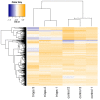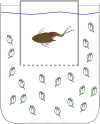Proteomic analysis of Daphnia magna hints at molecular pathways involved in defensive plastic responses
- PMID: 24762235
- PMCID: PMC4236883
- DOI: 10.1186/1471-2164-15-306
Proteomic analysis of Daphnia magna hints at molecular pathways involved in defensive plastic responses
Abstract
Background: Phenotypic plasticity in defensive traits occurs in many species when facing heterogeneous predator regimes. The waterflea Daphnia is well-known for showing a variety of these so called inducible defences. However, molecular mechanisms underlying this plasticity are poorly understood so far. We performed proteomic analysis on Daphnia magna exposed to chemical cues of the predator Triops cancriformis. D. magna develops an array of morphological changes in the presence of Triops including changes of carapace morphology and cuticle hardening.
Results: Using the 2D-DIGE technique, 1500 protein spots could be matched and quantified. We discovered 179 protein spots with altered intensity when comparing Triops exposed animals to a control group, and 69 spots were identified using nano-LC MS/MS. Kairomone exposure increased the intensity of spots containing muscle proteins, cuticle proteins and chitin-modifying enzymes as well as enzymes of carbohydrate and energy metabolism. The yolk precursor protein vitellogenin decreased in abundance in 41 of 43 spots.
Conclusion: Identified proteins may be either directly involved in carapace stability or reflect changes in energy demand and allocation costs in animals exposed to predator kairomones. Our results present promising candidate proteins involved in the expression of inducible defences in Daphnia and enable further in depth analysis of this phenomenon.
Figures






Similar articles
-
Interclonal proteomic responses to predator exposure in Daphnia magna may depend on predator composition of habitats.Mol Ecol. 2015 Aug;24(15):3901-17. doi: 10.1111/mec.13287. Epub 2015 Jul 20. Mol Ecol. 2015. PMID: 26111196
-
Uncovering ultrastructural defences in Daphnia magna--an interdisciplinary approach to assess the predator-induced fortification of the carapace.PLoS One. 2013 Jun 12;8(6):e67856. doi: 10.1371/journal.pone.0067856. Print 2013. PLoS One. 2013. PMID: 23776711 Free PMC article.
-
Pricklier with the proper predator? Predator-induced small-scale changes of spinescence in Daphnia.Ecol Evol. 2021 Nov 17;11(23):17080-17090. doi: 10.1002/ece3.8346. eCollection 2021 Dec. Ecol Evol. 2021. PMID: 34938494 Free PMC article.
-
Inducible Defenses with a "Twist": Daphnia barbata Abandons Bilateral Symmetry in Response to an Ancient Predator.PLoS One. 2016 Feb 17;11(2):e0148556. doi: 10.1371/journal.pone.0148556. eCollection 2016. PLoS One. 2016. PMID: 26886196 Free PMC article.
-
Ecological and evolutionary factors of intraspecific variation in inducible defenses: Insights gained from Daphnia experiments.Ecol Evol. 2020 Aug 3;10(16):8554-8562. doi: 10.1002/ece3.6599. eCollection 2020 Aug. Ecol Evol. 2020. PMID: 32884639 Free PMC article. Review.
Cited by
-
Differences in alternative splicing events in the adaptive strategies of two Daphnia galeata genotypes induced by fish kairomones.BMC Genomics. 2024 Jul 26;25(1):725. doi: 10.1186/s12864-024-10643-1. BMC Genomics. 2024. PMID: 39060996 Free PMC article.
-
Proteomic Profile of Daphnia pulex in Response to Heavy Metal Pollution in Lakes of Northern Patagonia.Int J Mol Sci. 2025 Jan 6;26(1):417. doi: 10.3390/ijms26010417. Int J Mol Sci. 2025. PMID: 39796269 Free PMC article.
-
Uncovering the chemistry behind inducible morphological defences in the crustacean Daphnia magna via micro-Raman spectroscopy.Sci Rep. 2020 Dec 29;10(1):22408. doi: 10.1038/s41598-020-79755-4. Sci Rep. 2020. PMID: 33376239 Free PMC article.
-
Transcriptional profiling of predator-induced phenotypic plasticity in Daphnia pulex.Front Zool. 2015 Jul 25;12:18. doi: 10.1186/s12983-015-0109-x. eCollection 2015. Front Zool. 2015. PMID: 26213557 Free PMC article.
-
Transcriptional and Translational Relationship in Environmental Stress: RNAseq and ITRAQ Proteomic Analysis Between Sexually Reproducing and Parthenogenetic Females in Moina micrura.Front Physiol. 2018 Jul 2;9:812. doi: 10.3389/fphys.2018.00812. eCollection 2018. Front Physiol. 2018. PMID: 30013488 Free PMC article.
References
-
- Bradshaw AD. Evolutionary significance of phenotypic plasticity in plants. Adv Genet. 1965;13(1):115–155.
-
- Pigliucci M. Phenotypic Plasticity: Beyond Nature and Nurture. Baltimore: Johns Hopkins University Press; 2001.
-
- Tollrian R, Harvell CD. The evolution of inducible defenses: current ideas. Ecol Evol Inducible Defenses. 1999. pp. 306–321.
Publication types
MeSH terms
LinkOut - more resources
Full Text Sources
Other Literature Sources

